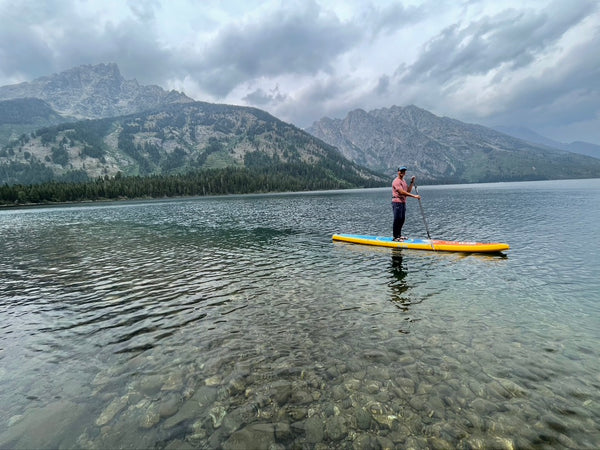
How Windy is Too Windy to SUP?
Wondering just how gusty conditions have to be before you reconsider your stand-up paddleboarding (SUP) plans? For newcomers to SUP, gauging manageable wind speeds can be a bit of a puzzle. Not to worry, though! We're here to demystify wind conditions for paddleboarding, ensuring you're prepped and ready for an enjoyable experience on the water
Ideal Conditions for Paddleboarding
Imagine an almost perfect day: warm temperatures with a slight overcast and barely a whisper of wind. Yet, such idyllic conditions are often elusive, especially in regions where the weather tends to have a mind of its own. So, what's the threshold for wind conditions that separate a pleasant day on the board from one that's better spent onshore?
Beginners should look for days when the wind is blowing at less than 7 knots (about 8 miles per hour). This level of wind is manageable, especially if you're accompanied by a more seasoned paddler. For those with a bit more experience, paddling in winds up to 12 knots (around 14 miles per hour) can still be enjoyable, though expect a bit more challenge and less relaxation.

Tips for Paddleboarding in Less Than Ideal Weather
Weather can be unpredictable, and even with a clear forecast, conditions can shift rapidly. Here's how to stay safe and still have fun if the weather decides to throw you a curveball while you're out on your SUP:
- Reduce Your Wind Resistance: When the wind picks up, your body can act like a sail. To counteract this, consider kneeling or lying down on your board to make it easier to paddle against the wind.
- Opt for Quick, Short Strokes: This technique helps minimize the time your paddle is exposed to the wind, making it easier to maintain control.
- Adjust Your Stance: Shifting your feet slightly forward or backward on the board can help reduce wind resistance, making it easier to navigate in gusty conditions.
- Seek Shelter: Utilize natural landscapes and obstacles to shield yourself from the wind. Knowing your paddling area well can help you find the best routes that offer protection from strong breezes.

How to paddle on a windy day
Wind can be one of the hardest weather conditions to predict because the wind conditions where you’re paddling could be completely different from the wind conditions at the weather station that you are getting a wind report from due to terrain and other factors. Here are some tips so you don’t have to panic if you ever get caught out in unexpected winds.
Minimize your body’s profile. Your body is going to start acting like a sail on windy days. To minimize how much the wind pushes you around, get on your knees or even lay down. This will make it a lot easier to paddle against the wind.

Use quick, short strokes. This will minimize the amount of time your paddle spends in the wind when you take it out of the water. You should try to orient the blade of the paddle so that the wind hits it on the edge instead of its wide face. You would be surprised at how much of a difference this makes.
Shift the position of your feet. Moving your feet a few inches forward on the board will shift the center of balance forward so that the nose of your board causes less wind resistance. If the wind is coming from behind you and not in front of you, shift your stance back a few inches.
Use obstacles and landmarks to block the wind. Hugging the shore to take advantage of landmarks that might block some of the wind is another strategy to minimize the impact of wind. If you paddle somewhere often, you might develop a route that will let you get where you want to go while being shielded from the worst of the wind.

Finding Accurate Weather and Wind Forecasts
Your basic weather app might not always give the most accurate wind conditions for your specific paddling location. Sites like Windfinder.com or checking the weather forecasts from nearby airports can offer more precise information. Understanding weather patterns, especially those related to the specific bodies of water you frequent, can significantly enhance your SUP experience.

Diurnal canyon winds are the worst on long Summer days when the sun has plenty of time to heat up the rock and air in the canyon. These patterns aren’t exactly the same in every canyon, but you will notice the daily wind patterns at any canyon reservoir you visit frequently.
Embrace the Adventure with Glidesup.com
Armed with these tips and a keen understanding of how to navigate various wind conditions, you're ready to make the most of your paddleboarding experiences. Whether you're a beginner or an experienced paddler, there's always something new to learn and explore in the world of SUP.
Related Topics
Improving Fitness on Paddle Board
How Many Calories Does SUP Burn?

